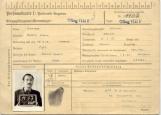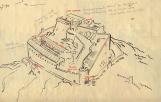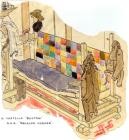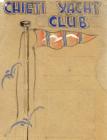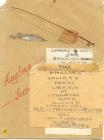5
The Unit mustered in Weymouth and although it only stayed there for only a short time, it gave a few members an opportunity to "wet their feet". About six were chosen to provide additional fire power on two trawlers which had been fitted with degaussing gear to neutralize magnetic mines. Unfortunately nothing materialized and the expedition was concluded. It was during this expedition that Buxton resolved never to be a sailor!The Unit was quickly fully mustered and sent to Scotland where they found their home for the next several months to be the old ship "Glengyle", moored in Loch Fyne at Inverary. After several months of very strenuous training, including night exercises and extremely tough and long marches through the hills, Buxton was recommended for a Commission and was sent to Sandhurst where he graduated from the Armoured Corps Wing as a Second Lieutenant in early 1941.
Buxton was then posted to 9th Battalion Royal Tank Regiment then stationed at Otley in Yorkshire from where, shortly, after arrival, the Battalion was supplied with the first "Churchill Tanks" and then was relocated to the south coast at Eastbourne.
From here Buxton received his "marching orders" and in 1941 was posted to the Middle East, a journey which took many weeks as the Mediteranean Sea was a hotbed of trouble with all parties attempting to sink anything in sight. The Battalion was forced to make a detour almost to the Azores and moored eventually in the harbour in Freetown, Sierra Leone.
The troops then left Sierra Leone in convoy and moored for two days in Cape Town harbour before proceeding through the Straights of Madagascar up through The Red Sea to Port Tewfiq.
Buxton spent about two months at Abbasia barracks in Cairo before being posted to 44th Battalion Royal Tank Regiment which was, at that time, located in Box 150 on the east side of the Gazala line which terminated at Bir Hacheim, then occupied by the Free French forces. These "Boxes" were positioned strategically behind the Gazala line to provide immediate response should the line be breached.
However Rommel, realized the difficulties of attempting to breach the line at the Mediterranean end and making a successful frontal attack, decided to take his troops south to Bir Hacheim, where they liquidated the Free French forces who fought very well but were outnumbered and outclassed. It was a day in late May 1942 when it was realized that Rommel not only had quickly dealt with the Free French forces but had also managed to get between the Allied Troops and Cairo.
So the battle began. Later, the fiercest battles were fought in two areas known as the "Cauldron" and "Knightsbridge".
The Allied forces were hopelessly outgunned by the Germans who brought in their 88mm guns which decimated an entire Battalion of our tanks (we lost over 50 tanks) in a few days. The only opposition the Allied tanks could provide was from the "two pounder" which could, with luck at 500 yards, knock the paint off the German tanks.
In actual fact, it was being outgunned which resulted in Buxton subsequently being captured in the desert in Libya.
Buxton had to bail out of two tanks. The first time, his tank was hit by an armour piercing shell which, after damaging the engine and causing a lot of smoke inside the turret, ricocheted around inside the tank and struck the gunner. Buxton had to extract himself and his badly wounded gunner. It was later discovered that the gunner had the unexploded armour piercing shell imbedded in his thigh.
The second bail out was unfortunately into the arms of a German Infantry Platoon.
Buxton then became, along with a number of other British troops, a "KREIGENFANGER".
7
Ronald Edwin BuxtonPrisoner of War Camp Identification - 1943
8
Buxton was detained in the Bir Hacheim area by the Germans where he saw Rommell himself. Buxton wondered if he is the most "senior" Veteran that saw Rommell alive.The Germans then passed Buxton on to the Italians in Derna (Libya) and he was eventually taken to Taranto (possibly the largest seaport) located on the southern heel of Italy. The POWs were transported in the belly of an old Italian freighter and were battened down for the four day journey.
On arrival the POWs loudly cheered the sight of the remainder of the Italian fleet which had recently been severely bombed and would appear to have been put out of action for possibly the rest of the war.
The Italians did not like this reaction so when we had disembarked our heads were closely shaved.
This was just as well as when we got to Tuturano (between Brindesi and Taranto) the huts were so full of fleas and bedbugs there was barely room for any of the POWs.
From Tutarano we were moved by the Italians north to Gavi, a six hundred year old castle, from which the Italians boastingly stated that no POW would ever escape. This "myth" was shattered a short time later by three determined and ingenious POWs, much to the embarrassment of the Italians.
10
POW CampGavi, Italy
Buxton arrived in Gavi in July 1943.
A few months later, Buxton was transported to Chieti, located on the east coast of Italy. Here Buxton (along with about forty other POWs) contracted hepatitis. They all recovered in spite of the fact that the Germans had taken all the medicine so there was nothing to treat the prisoners with.
Accommodation was sparse - eight men to a very small room.
12
Buxton spent the summer of 1943 in Chieti. This was his area......Castello Buxtoni a.k.a.
Squalor Corner
An important part of the prisoner's job was to attempt to escape and to that end they came up with some very ingenious ways to cover up their activities. They had to assemble undetected so formed clubs in order to hatch their plans.
14
Chieti Yacht ClubAngling Club
16
Sometimes the gathering was to hide the noise created by the actions of others who were tunnelling.Buxton's role was as a soil disperser which was siphoned slowly and placed in garden plots that Officer's were allowed to grow with seeds from the Red Cross, or in one case transferring the soil to an unused attic. Empty milk tins were used to fashion a fresh air line for the tunnel diggers. Whenever possible, German guards were bribed or particular prisoners were chosen to become friendly with certain guards and then goods and information was exchanged. Once this occurred the guard could be blackmailed to continue to provide aid.
When the Italians capitulated in Sept 1943, the POWs in the camp were again rounded up by the Germans and conveyed in cattle trucks to Moosberg, a short distance from Munich. This was a very large camp (reputedly holding 22,000 displaced persons) surrounded by a very high barbed wire fence which enclosed a number of smaller compounds for prisoners of war of various nationalities.
Buxton was asked if he knew about any of the atrocities which were being perpetrated by the Germans. Buxton said he knew nothing until after the war but remembered an incident in Moosberg where the Germans had brought cattle trucks filled with half-dead Russians and other nationalities who were put into the smaller compound next to the one in which we were housed. It would appear that the occupants of the cattle trucks who had been traveling for 12 to 14 days without food or sanitation were either dead or only half alive. Those who appeared partially mobile were thrown into the adjoining compound where they created a situation which resulted in the Germans releasing three attack dogs into the group. The dogs were no match against the starving detainees who killed and ate the dogs. Their remains were thrown back at the Germans!
From Mooseburg Buxton was transferred to Marishe Trubau in Czechoslovakia and finally to Braunschweig, Germany. Moves of POW Officers occurred occasionally to discourage Allied bombing of targets by placing the Officers close to operating German facilities such as airfields, military barracks, factories and the Autobahn.
Frequently they were bombed by the Americans during the day and, in fact were the target of a very large raid which killed or injured a number of POWs.
We were eventually liberated on April 12, l945 by the 125th US Cavalry.
17
Prisoners of the Braunschweig prisoner of war camp on the day of their release.1945
Braunschweig, Germany
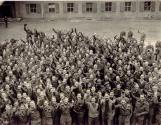
18
After they were liberated they were flown to Brussels where they were stripped down, de-loused, and showered. The liberated POWs then were dined, issued new battle dress and flown home.Buxton concluded that the happiness of getting back into the bosom of his family was marred by the announcement by his bank manager that a substantial portion of his pay had been taken to honour chits which had been given out by the senior British Officer in the camps to buy food on the black market to augment food which should have been supplied by the Italians and Germans.
Following the end of the war, Buxton joined the civilian workplace. He immigrated to Canada in 1958 and eventually ended up on Vancouver Island.
Buxton now resides in Nanaimo and continues to be a staunch supporter of many Military Associations.
He also contributes to the development of Canada's future by proudly supporting 205 Collishaw Royal Canadian Air Cadet Squadron.
Ronald E. Buxton died in Nanaimo on 30 May, 2007.
